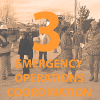Emergency Operations Coordination

Capability 3: Emergency Operations Coordination
Function 1: Conduct preliminary assessment to determine need for public activation
Function 2: Activate public health emergency operations
Measure 1: Time for pre-identified staff covering activated public health agency incident management lead roles (or equivalent lead roles) to report for immediate duty. Performance Target: 60 minutes or less
Function 3: Develop incident response strategy
Measure 1: Production of the approved Incident Action Plan before the start of the second operational period
Function 4: Manage and sustain the public health response
Function 5: Demobilize and evaluate public health emergency operations
Measure 1: Time to complete a draft of an After Action Report and Improvement Plan
Emergency Operations Coordination: Online Trainings
 Community Partnering: A Risk Assessment & Emergency Operations Planning Scenario
Community Partnering: A Risk Assessment & Emergency Operations Planning Scenario
This course, developed by the Upper Midwest Preparedness and Emergency Response Learning Center, provides guidance on the fundamentals of community-based planning, from contributing to a risk assessment to developing emergency operations plans (EOP) and engaging the whole community in addressing all risks and hazards. The course is intended for local public health administrators and local county emergency managers. Time estimated to complete is 1 hour.
IS-700.a: Introduction to the National Incident Management System (NIMS)
This course introduces and overviews the National Incident Management System (NIMS). NIMS provides a consistent nationwide template to enable all government, private-sector, and nongovernmental organizations to work together during domestic incidents.
IS-704 NIMS Communications and Information Management
This interactive computer-based course introduces you to the Communications and Information Management component of the National Incident Management System (NIMS). NIMS provides a consistent nationwide template to enable all government, private-sector, and nongovernmental organizations to work together during domestic incidents. Effective emergency management and incident response activities rely on flexible communications and information systems that provide a common operating picture to emergency management/response personnel and their affiliated organizations. Establishing and maintaining a common operating picture and ensuring accessibility and interoperability are the principal goals of the Communications and Information Management component of NIMS. Properly planned, established, and applied communications enable the dissemination of information among command and support elements and, as appropriate, cooperating agencies and organizations.
Emergency Operations Coordination: Resources
Building a Continuity of Operations Plan Tip Sheet
This Ready Tip sheet developed by the Advanced Practice Centers includes advice on Identifying and Prioritizing Critical Health Services and 10 Tips for Local Health Departments to Simplify the COOP Process.
Public Health Mutual Aid Agreements
The Cambridge Advanced Practice Center for Emergency Preparedness has developed materials to assist local health departments in creating public health mutual aid agreements. These materials have been used to develop and implement a public health mutual aid agreement in a 27-community region in Massachusetts. The materials include 5 PDF documents that can help local health departments begin the process of creating jurisdiction appropriate mutual aid agreements: Public Health Mutual Aid Agreement: A Template Explanation of a Public Health Mutual Aid Agreement Scenarios for Use of a Public Health Mutual Aid Agreement Frequently Asked Questions: Public Health Mutual Aid A Public Health Mutual Aid Agreement: White Paper
Emergency Operations Coordination: Drills & Exercises
Disaster in Franklin County: A Public Health Simulation
This simulation, developed by University of Minnesota Center for Public Health Education and Outreach, consists of 14 chapters occurring over the first 30 days following a severe storm striking the fictional community of Franklin County. In this simulation, which takes approximately 45 minutes to complete, the learner will assume the perspective of various public health professionals responding to a natural disaster. They will make decisions on behalf of a county public health director, a public health nurse, an environmental health specialist, and other public health professionals. By approaching the emerging public health issues from these perspectives, the players gain a deeper understanding of the issues at hand, the decisions that colleagues in other disciplines face, and how those decisions impact his or her area of expertise.
Conducting a BT- Table Top: A How-To Guide
The purpose of Conducting a BT-Table Top: A “how-to” guide is to provide state and local public health entities with information and guidance on the key ingredients to consider when developing and facilitating a tabletop exercise. Tabletop exercises are one of the strategies that the public health workforce can use to convene and engage their community partners. The guide was developed by DeKalb County Board of Health’s Center for Public Health Preparedness.
IS-522: Exercising Continuity Plans for Pandemics
This course, from FEMA Emergency Management Institute, is based on the pandemic continuity tabletop exercise Determined Accord. The course covers fundamental continuity principles and processes but is focused on the special continuity requirements for pandemics. Strategies such as telework and other social distancing strategies are described as well as special protection strategies for first responders, healthcare personnel, and others who have daily contact with the public. The flexible delivery version of this course includes the Determined Accord tabletop exercise based on the recent H1N1 pandemic. In this online version, students watch a discussion among first responders and respond to related questions.